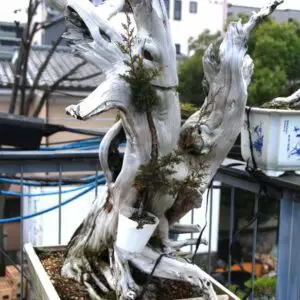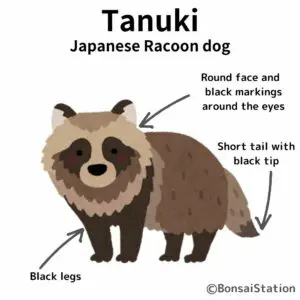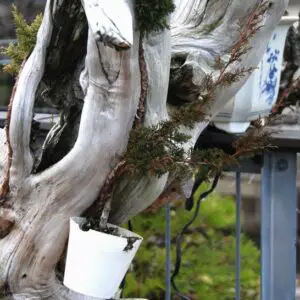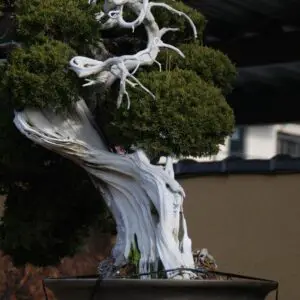What is Tanuki Bonsai?
Tanuki bonsai: definition

Tanuki bonsai in making
Historically, a Tanuki bonsai is a bonsai made by grafting, the technique often used when making a Shimpaku juniper bonsai. The definition of Tanuki bonsai nowadays involves attaching a living tree to a piece of deadwood to create a new bonsai tree.

Tanuki (Japanese racoon dog)
Tanuki is a kind of raccoon native to East Asia. Tanuki is often depicted in Japanese folklore as a mischievous and playful creature with magical abilities, such as shape-shifting with a leaf on its head used as a magic wand.
It is unclear why the term “Tanuki”, which is an animal and not a plant, came into bonsai but I think it can mean two things in the context of bonsai:
- It actually refers to a near homophone of “Ta-no-ki” in Japanese, meaning “other tree”, as it uses pieces from other dead trees to make a living bonsai tree.
- It refers to using deadwood to create the illusion of an older tree, much like the tricks associated with the Tanuki in Japanese folklore.
History of Tanuki bonsai
Historically, a Tanuki bonsai is a bonsai made by grafting, the technique often used when making a Shimpaku juniper bonsai.
Shimpaku junipers grow in high mountains. They endure cold wind and snow for many years that naturally leave some of their branches and trunks dead. Bonsai was originally made by collecting such trees in the mountains and planting them in pots to shape them (this type of bonsai making is called “Yamadori”).
In the 1960s in Japan, however, it became very difficult to collect excellent trees for bonsai making in the mountains because all of them were already taken by then. Around this time, people invented a method of grafting Shimpaku juniper onto an old, good, living tree of the same genus but not exactly Shimpaku juniper, which then was relatively easy to find for Yamadori.
In other words, they started using other types of trees as rootstocks, grafting young branches of Shimpaku juniper to it and calling it a Tanuki bonsai.
Using this method, it is possible to produce a Shimpaku juniper bonsai with an appearance of an old tree in a much shorter period of time than making one from cuttings or layered trees.
Tanuki bonsai nowadays

Tanuki bonsai
The definition of Tanuki bonsai nowadays involves attaching a living tree to a piece of deadwood to create a new bonsai tree. In other words, a living tree is attached to another dead tree with “Shari” or “Jin” to make it look as if it has been grown for many years.
But why does Tanuki bonsai, which used to mean grafting a living tree onto another living, old tree, come to represent the attachment of a living tree to a dead tree?
Here are my guesses.
In the 1960s, there was an abundance of trees in nature that were not particularly good for bonsai making but can be excellent candidates for rootstocks when grafted. However, after taking all of those trees from the mountains, the rootstock trees also disappeared.

Tanuki bonsai (deadwood carved )
So this time around, people came up with the idea of attaching a living tree to a dead tree that has excellent bonsai deadwood features but had withered. The deadwood is typically carved so that the living tree can be grafted onto it to make one bonsai tree, a Tanuki bonsai.
To know more about bonsai deadwood, the following post might be helpful.
Benefits of using the Tanuki Bonsai technique
There are several benefits to using the Tanuki bonsai technique when making a bonsai tree.
Revives dead bonsai trees
One of the main benefits of the Tanuki Bonsai technique is that it can be used to revive/reuse dead bonsai trees that had excellent deadwood features. By grafting a living tree onto a piece of marvelous deadwood, you can breathe new life into a bonsai tree that might otherwise be wasted (or thrown away).
Creates mature-looking bonsai trees
Another benefit of using the Tanuki Bonsai technique is that it allows you to create mature-looking bonsai trees in a relatively short period of time. Using a piece of deadwood from a matured tree, a Tanuki bonsai tree appears to have an old, weathered trunk, even though the living tree itself may be relatively young.
Saves time and effort
Traditional bonsai techniques require many years of careful pruning and shaping to achieve the desired result. It may take a few decades for a bonsai tree to have a truly matured appearance when grown from seed or cutting.
Tanuki bonsai technique, on the other hand, allows you to create a mature-looking tree in a fraction of the time. After 10 years of making a Tanuki bonsai, you can enjoy a fully-grown, excellent bonsai tree.
Best species for Tanuki Bonsai

Shari and Jin
Tanuki bonsai technique is not for all bonsai species; certain species are better suited for this technique than others. As it involves attaching a living tree to a piece of deadwood to create a new bonsai tree, tree species best suited for bonsai deadwood, which is coniferous trees, are also good for Tanuki bonsai.
Junipers are a popular choice for Tanuki bonsai because they are especially praised for their unique deadwood features. They are also hardy and can withstand strong wiring to be made into various tree shapes when making a Tanuki bonsai.
Is Tanuki bonsai for beginners?
It is always helpful to have some prior experience with bonsai making before trying any new technique and it is more so to attempt the Tanuki Bonsai technique.
It is important to keep in mind that the Tanuki Bonsai technique involves grafting a living tree onto a piece of deadwood, which can be a delicate process. If you are not familiar with bonsai care or grafting techniques, it may be difficult to create a bonsai tree and keep it alive and healthy while maintaining its style.
Also, selecting the right piece of living tree and deadwood is important for the success of the technique. You should at least know how to style a bonsai tree using deadwood features to assemble different pieces of trees in making Tanuki bonsai, which may be difficult for a beginner.



